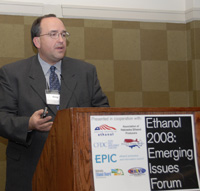On Saturday in Indiana, Presidential candidate Barack Obama echoed what a Nobel laureate in physics said Wednesday in Nebraska – corn-based ethanol is a transitional technology.
 During a campaign stop in corn country over the weekend, the Terre Haute News reports that Senator Obama was asked what he thought about corn-based ethanol.
During a campaign stop in corn country over the weekend, the Terre Haute News reports that Senator Obama was asked what he thought about corn-based ethanol.
Obama answered, “We spend a billion dollars a day sending money to foreign nations because of our addiction to foreign oil. Oil prices are at the highest level in history, and they’re not going down anytime soon.
“China and India need fuel for growth — there are a million Chinese who don’t have a car who want a car,” he said.
After saying that alternative fuels and energy sources will be the necessary next step for breaking America’s dependence on foreign oil, Obama said, “Corn-based ethanol is not optimal. I’ve been a big supporter of corn-based ethanol. I come from a corn state — Illinois — and it’s a good transitional technology, but the truth is, it is not as efficient as what the Brazilians are doing with sugar cane.”
Obama continued, saying that more money needs to be devoted to researching and developing additional forms of alternative energy.
 Dr. Steven Chu, director of the Lawrence Berkeley National Laboratory in California, said much the same at the 25x’25 Renewable Energy Summit last week in Omaha, according to Truth About Trade & Technology.
Dr. Steven Chu, director of the Lawrence Berkeley National Laboratory in California, said much the same at the 25x’25 Renewable Energy Summit last week in Omaha, according to Truth About Trade & Technology.
“Corn is not the right crop for biofuels,” said Chu, who won the Nobel Prize in physics in 1997 and is co-chairman of a study on sustainable energy by an international scientific council.
Chu and his California team of researchers are trying to develop new fuels that will be dramatically more efficient to make than either corn-based ethanol or soybean-based biodiesel.
Currently, corn is the least costly feedstock for making ethanol. The ethanol demand has more than doubled corn prices in the last two years, raising concerns about its effects on food prices.
But within five to 10 years, Chu said, scientific discoveries and refining processes could improve enough to move grasses, woody substances and waste to the head of the line for making fuels. Some grasses could provide five times the amount of fuel from an acre as corn.
Unlike corn, many of the feedstocks can be grown on marginal land not normally used for food crops.
“We should look at corn as a transitional crop,” Chu said.
That’s what supporters of ethanol have been trying to tell the critics all along, that corn is a stepping stone to newer, more efficient biofuels. It’s nice to hear someone else say it.
 Range Fuels has been held up as the poster child for commercializing cellulosic ethanol and the company has now raised $100 million to build a 100-million-gallon-a-year plant in Georgia. Range Fuels has also received a US Department of Energy grant and other venture funding in an effort to get the plant up and producing at least 20 million gallons of ethanol from wood this year.
Range Fuels has been held up as the poster child for commercializing cellulosic ethanol and the company has now raised $100 million to build a 100-million-gallon-a-year plant in Georgia. Range Fuels has also received a US Department of Energy grant and other venture funding in an effort to get the plant up and producing at least 20 million gallons of ethanol from wood this year.


 The funding will help Liberty purchase equipment to improve its ability to move and/or load and unload train cars, according to the release. By utilizing existing railroad, Liberty will have a greater ability to use different feed stocks to produce biodiesel, the statement continued.
The funding will help Liberty purchase equipment to improve its ability to move and/or load and unload train cars, according to the release. By utilizing existing railroad, Liberty will have a greater ability to use different feed stocks to produce biodiesel, the statement continued. Several ethanol producers are among the winners of the 14th annual
Several ethanol producers are among the winners of the 14th annual  During a campaign stop in corn country over the weekend, the
During a campaign stop in corn country over the weekend, the  Dr. Steven Chu, director of the Lawrence Berkeley National Laboratory in California, said much the same at the 25x’25 Renewable Energy Summit last week in Omaha, according to
Dr. Steven Chu, director of the Lawrence Berkeley National Laboratory in California, said much the same at the 25x’25 Renewable Energy Summit last week in Omaha, according to  Continental Airlines will run a test flight on biofuel sometime next year.
Continental Airlines will run a test flight on biofuel sometime next year. In honor of Rudolph Diesel’s birthday on March 18, 1858, today is National Biodiesel Day! As you might know, the inventor of the diesel engine advocated for the use of vegetable oil (in particular peanut oil) to power his fuel-efficient invention. Today, biodiesel is the manifestation of Diesel’s vision, as it provides a clean source of renewable energy for the world.
In honor of Rudolph Diesel’s birthday on March 18, 1858, today is National Biodiesel Day! As you might know, the inventor of the diesel engine advocated for the use of vegetable oil (in particular peanut oil) to power his fuel-efficient invention. Today, biodiesel is the manifestation of Diesel’s vision, as it provides a clean source of renewable energy for the world.


 According to Alan Rae, CEO of O2Diesel Corporation, “We believe KL has developed a commercially ready and environmentally friendly process and has a business model that can be easily replicated, which will provide the opportunity for rapid, wide-scale distribution of affordable fuel grade ethanol on a carbon positive basis. Additionally, the KL process provides the potential for multiple natural waste feedstocks, which supports global efforts to move renewable fuel production away from traditional agricultural feedstocks. Access to competitively priced ethanol from second generation production will further enhance the environmental benefits of O2Diesel as we expand our European and other markets.”
According to Alan Rae, CEO of O2Diesel Corporation, “We believe KL has developed a commercially ready and environmentally friendly process and has a business model that can be easily replicated, which will provide the opportunity for rapid, wide-scale distribution of affordable fuel grade ethanol on a carbon positive basis. Additionally, the KL process provides the potential for multiple natural waste feedstocks, which supports global efforts to move renewable fuel production away from traditional agricultural feedstocks. Access to competitively priced ethanol from second generation production will further enhance the environmental benefits of O2Diesel as we expand our European and other markets.” “Basically, three to four gallons of water per gallon of ethanol is used in the ethanol plant,” Krissek says. “A little over one gallon actually touches the corn in what we call the contact process.” The rest is called non-contact, which is for processes such cooling of the equipment, that mostly evaporates. And he says plants are becoming even more efficient with some already falling under three gallons of water per gallon of ethanol.
“Basically, three to four gallons of water per gallon of ethanol is used in the ethanol plant,” Krissek says. “A little over one gallon actually touches the corn in what we call the contact process.” The rest is called non-contact, which is for processes such cooling of the equipment, that mostly evaporates. And he says plants are becoming even more efficient with some already falling under three gallons of water per gallon of ethanol.